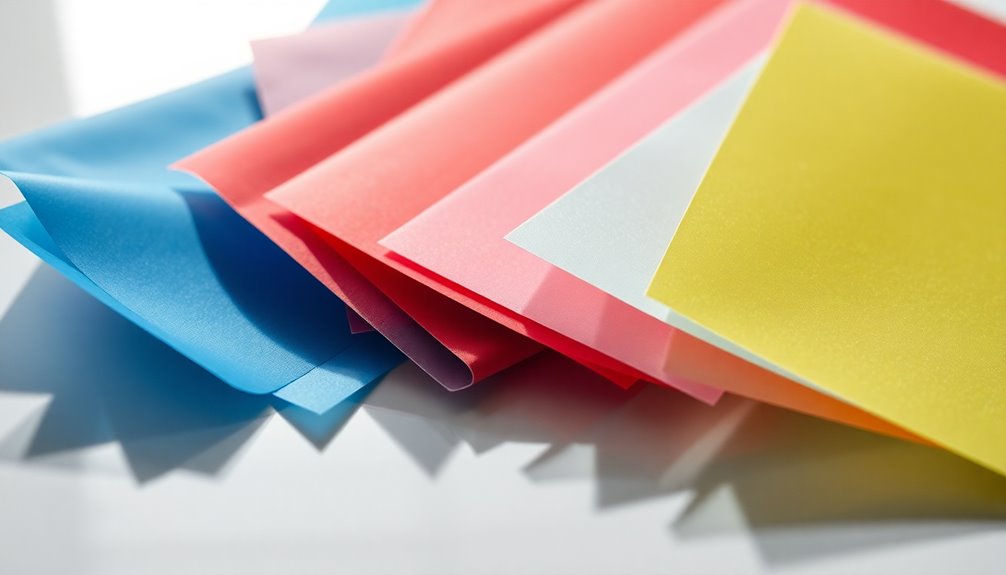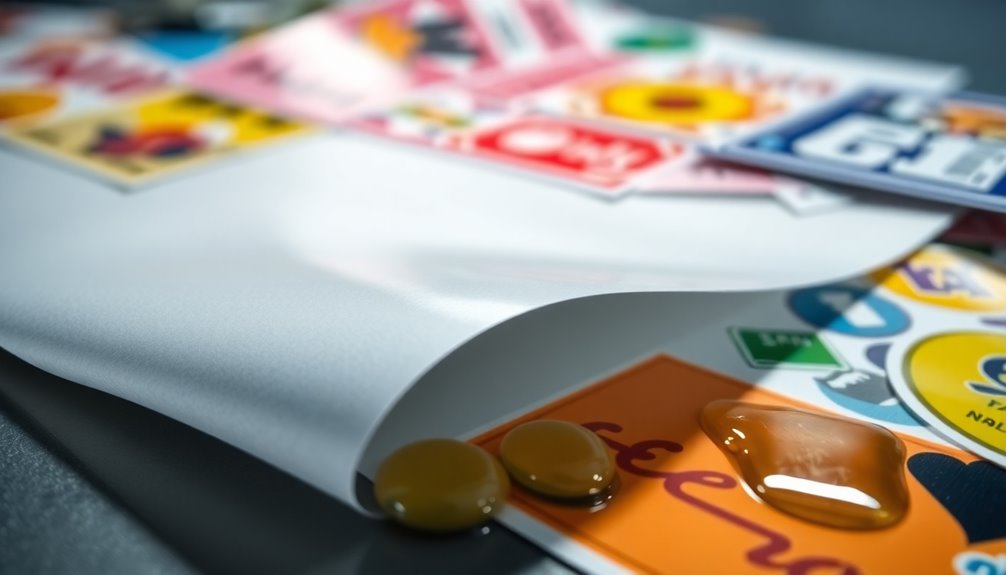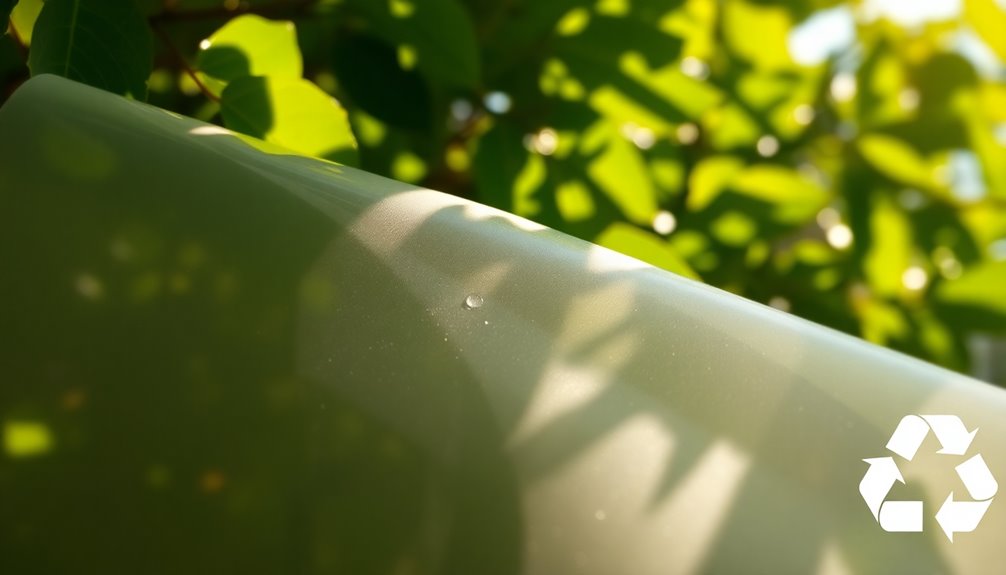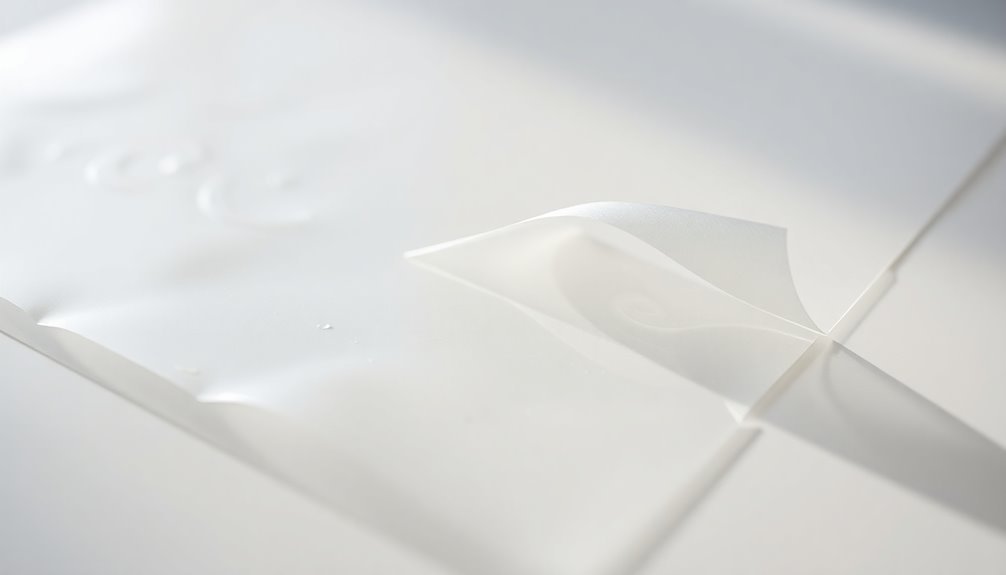Release paper is a protective layer you'll often find in industries like medical, automotive, and graphic arts. It's made from paper or film and coated with a release agent that prevents things from sticking. You can choose from different types, such as paper-based or film-based, depending on your needs. This material allows for easy removal of pressure-sensitive labels without damaging the adhesive underneath, preserving product integrity. Plus, some versions are designed to minimize contamination in sensitive applications. If you want to explore its benefits and types further, you'll find plenty of interesting details ahead.
Key Takeaways
- Release paper is a protective layer made from paper or film, coated with a release agent to prevent adhesion.
- It is primarily used in industries like medical, automotive, and graphic arts for pressure-sensitive labels and tapes.
- There are several types of release paper, including paper-based, film-based, and non-silicone, each catering to specific applications.
- Release paper ensures product integrity by preventing premature sticking, contamination, and maintaining adhesive performance during manufacturing.
- It also supports sustainability through recyclable options and responsible sourcing practices, minimizing environmental impact.
Definition of Release Paper

Understanding the role of release paper is fundamental for anyone working with adhesive products. Essentially, release paper is a temporary protective layer made from paper or film, coated with a release agent. This coating prevents adhesive products from sticking together before you're ready to use them. It serves as a carrier for pressure-sensitive labels, guaranteeing they can be transported to application surfaces without adhering to each other.
When it's time to apply the adhesive product, the release agent allows for easy removal of the release paper, protecting the integrity of the adhesive layer. This feature is significant in various industries, including medical, automotive, construction, and graphic arts, where maintaining the quality of adhesive surfaces during production is critical.
Release paper comes in different types, such as paper-based and film-based, each offering unique advantages tailored to specific application requirements.
Types of Release Papers

When you're choosing release paper, it's important to understand the three main types: paper-based, film-based, and non-silicone.
Each type has unique properties that cater to different applications, so knowing their strengths can help you make the right decision.
Let's explore how these options can serve your specific needs.
Paper-based Release Papers
Paper-based release papers come in various types, each designed to meet specific needs across multiple industries. These papers are cost-effective and versatile, making them ideal for applications like adhesive labels and medical products.
You'll find common types such as calendered Kraft paper, which is polished for smooth application, and polykraft paper, known for its thicker, moisture-resistant properties.
Often, these release papers feature a silicone layer that allows easy separation from sticky materials, preventing contamination and ensuring product integrity. This is especially important in industries like automotive, electronics, and graphic arts, where protecting adhesive surfaces before application is vital for efficient production processes.
Moreover, paper-based release papers can be customized for specific end uses, enabling manufacturers to tailor the release properties and surface characteristics to meet unique application requirements.
Film-based Release Papers
Film-based release papers offer a robust alternative to their paper counterparts, as they're crafted from materials like polyester (PET) or polypropylene.
These film release liners provide enhanced durability and moisture resistance, making them ideal for a variety of demanding applications in industries such as medical, automotive, and electronics.
Here are some key benefits of film-based release papers:
- Superior Barrier Properties: They excel in environments where moisture and chemicals are a concern.
- High Durability: Less prone to tearing or breaking, guaranteeing reliable performance during high-speed labeling and application processes.
- Clarity Maintenance: Ideal for clear labels where visual appearance is essential.
When you choose film-based release papers, you're improving the efficiency and effectiveness of adhesive applications, especially in wet or harsh conditions.
Their advanced design guarantees that your projects run smoothly, with minimal risk of failure.
Non-silicone Release Papers
Non-silicone release papers stand out as a reliable choice for applications requiring separation from sticky materials without the potential for silicone contamination.
These release liners are perfect for industries like electronics and medical devices, where cleanliness and precision in adhesive application matter greatly. By avoiding silicone-based release agents, you minimize the risk of contamination in sensitive environments.
You'll find that non-silicone options often feature coatings made from low surface energy materials, enhancing their performance for specialized applications. This makes them particularly effective when you need to guarantee that adhesives adhere only where intended.
Plus, non-silicone release papers can be more environmentally friendly. They tend to be easier to recycle and are less likely to cause pollution compared to their silicone-coated counterparts.
Available in various substrates, including paper and film, non-silicone release papers allow for customization based on your specific application requirements and performance needs.
When you evaluate used release options, consider how these papers can meet your project's demands while maintaining high standards of cleanliness and reliability.
Key Applications of Release Paper

Release paper finds its way into various industries, serving significant functions that enhance product performance and usability. Its wide range of applications makes it indispensable for many products, guaranteeing that adhesive surfaces remain protected until you're ready to use them.
Here are some key applications of release paper you might encounter:
- Pressure-sensitive labels and adhesive tapes: Release liners guarantee that adhesive surfaces are shielded until application, maintaining their effectiveness.
- Medical products: In the medical field, release paper safeguards adhesive components in wound dressings and surgical tapes, promoting hygiene and reliability.
- Electronics manufacturing: The electronics industry relies on release paper to protect adhesive layers in components like displays and touch screens, guaranteeing precise positioning and functionality.
Additionally, release paper plays an important role in automotive applications by preserving adhesive integrity in harsh environments, fundamental for vehicle assembly and maintenance.
It's also prevalent in graphic arts, where it's used for producing self-adhesive labels and decals, allowing for high-quality printing and easy application without damaging the adhesive.
With these applications, it's clear how essential release paper is across various sectors.
Importance Across Industries

Release paper is essential across various industries for ensuring product integrity and enhancing manufacturing efficiency.
You'll find it plays a key role in everything from medical supplies to electronics, where it safeguards adhesive performance under different conditions.
Plus, as environmental concerns grow, exploring sustainable options for release paper becomes increasingly important for responsible production practices.
Key Industry Applications
In many industries, protective layers play an essential role in guaranteeing adhesive products work effectively. Release paper, often referred to as release liners, is an important component that safeguards adhesive properties until the moment of application. Its applications span various sectors, each benefiting from its protective functions.
Consider these key industry applications of release paper:
- Medical Field: Protects adhesive components in wound dressings and surgical tapes, promoting hygiene and reliability.
- Electronics Industry: Safeguards adhesive layers in touch screens and displays, guaranteeing precise positioning during manufacturing.
- Automotive Applications: Maintains adhesive integrity in harsh environments, ensuring reliable performance in bonding materials.
These applications highlight how release paper enhances product quality and usability. By providing a protective barrier, it guarantees that adhesives remain effective and undamaged until they're ready to be used.
Whether it's in medical devices, consumer electronics, or automotive parts, using release paper is essential for maintaining the integrity of adhesive products across industries. By understanding its importance, you can appreciate how release paper supports various applications, ultimately contributing to the reliability and performance of numerous products you encounter daily.
Product Integrity Assurance
Maintaining product integrity is essential across various industries, and the role of release paper in achieving this can't be overstated. Release paper prevents adhesive surfaces from prematurely sticking or becoming contaminated during manufacturing and transportation. This reliability is critical for industries like medical, electronics, and automotive, where product quality directly impacts safety and performance.
Here's how release paper maintains product integrity across different sectors:
| Industry | Role of Release Paper | Benefits |
|---|---|---|
| Medical | Guarantees hygienic conditions for adhesive components | Enhances patient safety and reliability |
| Electronics | Protects adhesive layers during assembly | Guarantees precise positioning and functionality |
| Automotive | Maintains adhesive integrity in harsh environments | Contributes to durability and performance |
| Manufacturing | Reduces downtime during production | Minimizes adhesive mishaps |
| Overall | Streamlines production processes | Enhances operational efficiency |
In each of these applications, release liners are integral in preserving adhesive properties, guaranteeing that products meet the highest standards of integrity from start to finish.
Environmental Impact Considerations
Product integrity goes hand in hand with environmental sustainability, especially in industries reliant on adhesive applications.
Release liners play an essential role in minimizing waste and supporting eco-friendly practices. By choosing the right release paper, you can markedly reduce your environmental footprint.
Here are some key considerations:
- Waste Reduction: High-quality release papers prevent adhesive mishaps, which helps decrease material waste and enhances production efficiency.
- Recyclable Materials: Utilizing recyclable materials in the manufacturing of release papers aligns with responsible sourcing and supports sustainability initiatives.
- Industry Standards: Associations like CELAB and Afera advocate for sustainable forestry practices, ensuring that the production of release liners contributes positively to biodiversity and environmental health.
Manufacturing Considerations

Often, the choice of manufacturing method for release paper greatly impacts its overall quality and performance. You'll find that options like solvent-based, hot melt, and UV curing are typically chosen based on cost, performance, and environmental considerations.
The selection of raw materials, including substrates and release agents, plays an essential role in determining the properties of your release liners. If you aim for ideal performance, you need to be mindful of these choices.
Quality control measures during the manufacturing process are fundamental. They guarantee consistent thickness, smoothness, and release characteristics across batches, which is critical for maintaining product reliability.
Additionally, sustainability practices are becoming increasingly important. Sourcing materials from responsibly managed forests and minimizing waste generation not only benefits the environment but also enhances your brand's reputation.
Moreover, customization options are available in the manufacturing process, allowing you to create tailored release liners that meet specific industry requirements and applications.
Advantages of Release Paper

Experience the numerous advantages of release paper, which serves as an effective protective layer for adhesive surfaces. By utilizing release liners, you prevent premature sticking, ensuring your adhesive products remain intact during storage and transport. This protection is vital for maintaining product quality.
Here are some key benefits of using release paper:
- Enhanced Efficiency: The high-quality surface allows for smooth application of adhesive materials, improving production efficiency and reducing downtime in manufacturing processes.
- Versatility Across Industries: Release paper is compatible with a wide range of adhesive products, making it valuable in various sectors, including medical and automotive industries.
- Customizable Options: You can design release paper with specific release agent formulations tailored to meet your application needs, such as moisture resistance or adhesive compatibility.
Incorporating release paper into your processes not only improves performance but also contributes to sustainability, as many options are recyclable.
Environmental Impact and Sustainability

In today's world, the environmental impact of materials like release paper is more important than ever. As you consider your choices, you'll be pleased to know that the release liner industry is making strides toward environmental sustainability. Many manufacturers are adopting recyclable materials and committing to sustainable forestry practices, sourcing wood and fiber from well-managed forests. This not only promotes biodiversity but also reduces the overall ecological footprint.
To illustrate the positive changes in the industry, take a look at the following table:
| Practice | Impact |
|---|---|
| Sustainable Sourcing | Supports biodiversity and responsible forestry |
| Waste Minimization | Reduces environmental impact during production |
| Use of Recyclable Materials | Enhances end-of-life solutions |
| Adhesive Mishap Prevention | Lowers waste generation |
Industry associations like CELAB and Afera advocate for responsible practices, encouraging manufacturers to minimize waste and enhance sustainability. By choosing environmentally-friendly release papers, you're not just making a decision for your projects; you're contributing to a larger movement towards a more sustainable future.
Frequently Asked Questions
What Is the Use of Release Paper?
You'll find release paper invaluable in various applications. It acts as a protective barrier for adhesive surfaces, ensuring they don't stick together before you need them.
In industries like medical and food packaging, it maintains product integrity. You can also use it to transfer textures in coated fabrics.
Plus, with its reusable nature, you can enhance efficiency and sustainability in your manufacturing processes, making it a versatile tool in your operations.
What Does Paper Release Mean?
When you hear "paper release," it refers to the action of separating an adhesive product from its backing material.
This process relies on the release agent's effectiveness, enabling you to easily peel off labels or tapes without leaving residue.
You'll find this concept essential in many industries where ensuring smooth application is necessary.
Understanding how paper release works can help you choose the right materials for your projects, ensuring ideal performance and efficiency.
Why Use Release Paper on Diamond Painting?
Using release paper in diamond painting is a game changer. It keeps your adhesive protected, preventing it from sticking to itself before you place the diamonds.
You'll find it easier to position your diamonds accurately, minimizing any mess. Plus, it shields the adhesive from dust and other contaminants, ensuring your artwork stays pristine.
Is Release Paper Sticky?
No, release paper isn't sticky.
It's designed to be non-adhesive, allowing you to easily separate it from adhesive surfaces without leaving any residue.
You'll find it's coated with a release agent that prevents sticking, making it perfect for protecting your projects.
When you use it, you won't have to worry about your adhesive materials clinging together, ensuring everything stays clean and ready for application whenever you need it.
Conclusion
In summary, release paper is a versatile material that plays a vital role in various industries. Its different types cater to specific needs, ensuring effective performance in applications ranging from packaging to electronics. By understanding its importance and advantages, you can make informed choices that enhance your manufacturing processes. Plus, considering the environmental impact can lead to more sustainable practices. Embracing release paper not only boosts efficiency but also supports your commitment to sustainability.










